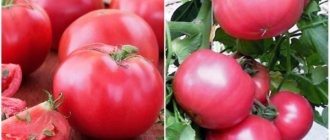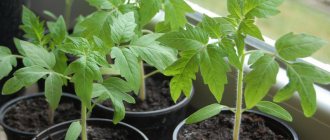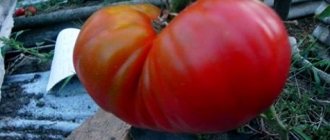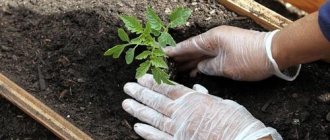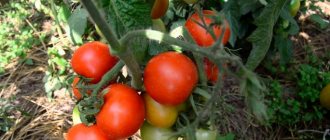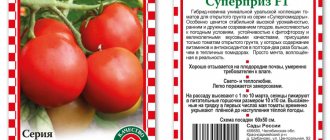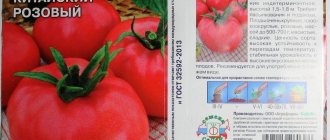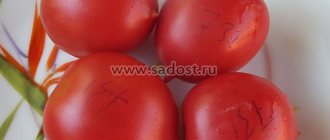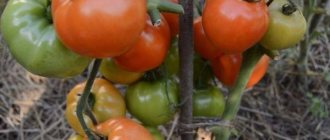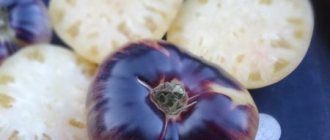The Raspberry Onslaught tomato is known for its almost record yield. This hybrid variety feels good in greenhouses and gardens, delights with large fruits and excellent taste.
| Height | Landing location | Ripening time | Fruit color | Fruit size | Origin | Fruit shape |
| Medium height | Greenhouse, Open ground | Mid-season | Pink | Large | Hybrid | Flat-round |
Productivity, cultivation and disease control
A distinctive feature of Raspberry Onslaught is its high yield.
If agrotechnical requirements are met, up to 40 kg of tomatoes can be harvested from 1 m² of area. In this case, not only large fruits are formed, but also medium and small ones. This versatility allows them to be used for preparing salads, preserves, ketchups and pastes. The variety has other advantages:
- development of a friendly ovary;
- rapid maturation;
- excellent immune system;
- absence of cracking of the peel of large fruits.
The disadvantages of the hybrid include the inability to collect a sufficient amount of planting material, that is, seeds. An amateur gardener will have to buy them before each new season.
The plant subtly responds to changes in humidity, air temperature and irrigation level. Therefore, it is recommended for cultivation in areas with a longer summer season.
Planting seeds in the ground should begin in late March - early April. If a tomato sprout has 1-2 true leaves, thinning is carried out - diving with the removal of weak and non-viable shoots. At this time, root feeding is carried out with the addition of organic and mineral elements.
It is recommended to harden them 10-14 days before transferring the seedlings to a permanent place of growth. Initially, the procedure is carried out for 15-20 minutes, and after 10 days this period is extended to several hours.
The description indicates the formation of large fruits, which forces gardeners to be very careful about the timely tying of the stems to the support pegs. Although the plant loves sunlight, high temperatures and lack of ventilation can cause blossom end rot. To prevent the disease, it is necessary to reduce the supply of nitrogen to the soil and increase the amount of calcium.
You can often hear reviews about the defeat of the Raspberry Onslaught by brown spot. To prevent this disease, you should reduce the amount of moisture and strictly monitor the temperature in greenhouses.
The greatest damage to the plant is caused by the Colorado potato beetle and its larvae. If the planting area is small, insects are collected and destroyed manually. If necessary, 2 weeks before the start of harvesting, the bushes are treated with chemicals.
Advantages and disadvantages
Anastasia tomatoes have a number of advantages, which include the following:
- Unpretentiousness. Throughout the entire growing period, it is not necessary to constantly care for the bushes. This variety copes without problems with lack of moisture, sudden climate changes and low temperatures.
- Fast growth. The bushes grow quite quickly to 60-70 cm. At the same time, soil fertility does not affect growth and development in any way, since the plant grows well even in soils with a small amount of nutrients.
- Disease resistance. Many hybrid varieties resist most diseases, and Anastasia is no exception.
- High yield. A large number of clusters with several fruits on them are formed on the bushes. It is thanks to this that this tomato variety has good yield.
Description of the tomato variety Heart of Ashgabat and its characteristicsRead
There are not too many disadvantages to such tomatoes. The most serious is that they have to be tied to supports.
Tomatoes Raspberry onslaught on video
If you have grown Raspberry Onslaught tomatoes, please write whether you liked them or not. What was the yield and taste of the fruits like under your climatic conditions? How do you rate the disease resistance of this variety? Briefly describe the advantages and disadvantages of this tomato in your opinion. If possible, attach a photo of your tomatoes to your comment. Thank you!
Your reviews of the Raspberry Onslaught tomato and additions to the description will help many gardeners evaluate this variety more objectively and decide whether it is worth planting or not.
The tomato variety “Raspberry Onslaught” is one of the most successful developments of Russian breeders. It is one of the elite varieties, which is characterized by increased productivity and stability, therefore it is valued among amateurs and farmers. The variety earned its name due to the characteristic color of the fruits, which have a beautiful crimson color.
Features of cultivation
Among the features of the “Raspberry Sweetness” tomato variety, many note its high yield and uniform fruit ripening. We can also say about resistance to common diseases of tomatoes in greenhouses.
Seeds for seedlings are sown in March-April. They dive at the stage of two true leaves. Plant bushes form one or two stems, usually two. The plant is tall and needs staking; this will serve as additional protection from the wind if it grows in open beds.
Raspberry sweet tomatoes are very demanding on thermal conditions and watering. At the development stage, it is very fond of fertilizing containing potassium and phosphorus. Watering with warm water in the evening 2-3 times a week, depending on the weather.
It is very important to choose the right soil, both for planting seedlings and for adult plants in the greenhouse. An article about types of soil for tomatoes will help you figure this out.
You will also find on our website information on how to prepare the soil for tomatoes yourself.
Read more about how to fertilize tomatoes correctly and with what:
- Organic, mineral, phosphorus, complex, ready-made fertilizers.
- TOP best.
- Yeast, iodine, hydrogen peroxide, ammonia, ash, boric acid.
- Fertilizers for seedlings, foliar and when picking.
Growing rules
The agricultural technology for growing tomatoes of the Nastenka variety is quite simple and traditional for determinate plants. However, despite a number of advantages, there are also disadvantages. When growing seedlings, a gardener must have certain skills, while beginners must be prepared for difficulties. It is necessary to clearly know and adhere to the rules of planting seedlings, transplanting tomatoes, as well as further caring for them.
Planting seedlings
Nastenka tomatoes are recommended to be grown in seedlings even in the Southern regions. The production of seedlings begins at the end of February or early March, sowing seeds in shallow containers filled with purchased ready-made soil, pre-treated and filled with the necessary elements. It is better to purchase seeds for sowing in specialized stores that sell them in processed form.
When using garden soil:
- It is necessary to disinfect it by heating or a solution of potassium permanganate.
- Before planting, the soil is watered and compacted a little.
- The seed placement depth is no more than 1 cm.
- Before germination, the container is covered with glass or film to retain moisture. It is kept at temperatures up to 25 ºС.
- With the emergence of seedlings, the shelter is removed, and the temperature is lowered for a week to 14 - 16 ºС so that the seedlings do not stretch out. Subsequently, the temperature is maintained at 20 – 22 ºС.
- Watering is carried out as the soil dries with warm water.
- Seedlings dive when 1-2 true leaves appear in separate seedling pots, cups or other containers with a volume of at least 8x8 cm.
To get strong, healthy seedlings, you need sufficient lighting for 15-16 hours, regular watering without waterlogging and lowering the air temperature at night.
Tomato transplant
At the age of 60-65 days, Nastenka tomato seedlings are planted in a permanent place in open ground or a greenhouse. By this time, the tomato seedling should have 6-8 true leaves and at least one flower cluster. Planting dates directly depend on the type of shelter, weather conditions of the region and last from early April to June.
Plants are planted less often in greenhouses than in open ground. On average, per 1 m² of protected soil, the consumption of seedlings is 3 plants, open - 4. Plants are planted at a distance of 40-45 cm from each other with row spacing of 60-70 cm.
Warning! With a higher planting density of tomatoes, lighting and ventilation deteriorate, which contributes to the development of diseases and reduced fruit set.
Tomatoes are planted in open ground in sunny, protected from the north wind, non-flooded areas with fertile soil of a loose structure. Best predecessors:
- beans;
- peas;
- cabbage;
- corn;
- forage grasses.
Re-growing tomatoes after nightshade crops, peppers, and eggplants is not allowed due to the risk of spreading specific diseases.
The holes are dug in such a way that the tomato seedlings fit in them to the full height of the root ball without damaging it, and a depression is formed for watering. Plant watered seedlings in well-moistened holes.
Attention! To reduce transplant stress, use growth stimulants in accordance with the manufacturer's recommendations. And to improve fertilization of ovaries - spraying with boron solution
Growing the Nastenka variety involves the same agrotechnical measures as when caring for other determinate tomatoes. Regular watering, which is carried out depending on the condition of the soil 1-2 times a week to the entire depth of the root system, has a positive effect on yield growth.
For the first feeding, use a solution of mullein or complex fertilizers with nitrogen, for the next - with a predominance of phosphorus and potassium. Fertilizing is combined with watering to prevent excess moisture. Mulching with sawdust and straw helps conserve moisture and protect row spaces from weeds, but this creates problems when loosening the soil.
Nastenka tomatoes produce a limited number of side shoots. In open ground, pinching may not be necessary, but in a greenhouse some of the shoots need to be removed to form a bush of no more than 3 stems. It is better to tie the tomato variety Nastenka to a support.
Growing tomatoes
How to prepare seeds?
Although the seeds of the “raspberry onslaught” are bought at a farm store, preliminary sorting and processing will still not be superfluous.
To find out which seeds are unsuitable, you need to pour them into a glass of warm salted water (1 tablespoon of salt) and wait 20 minutes. All empty seeds will float to the surface of the water.
After this, you can begin processing the seed material from possible fungal infections:
- Treating the seeds in a disinfectant solution, for example, 3% hydrogen peroxide (in order not to burn the seeds, keep the seeds in it for only 10 minutes).
- Heat treatment in the oven will help destroy fungal spores. To do this, pour the seeds onto parchment paper covered on a baking sheet and place them in the oven for 2 hours at a temperature of 50 C. The material must be stirred every 20 minutes so that it does not burn.
- Bioactivation with aloe juice, in which the seeds are placed for 12 hours, will improve the immunity of future seedlings.
Sowing seed material
Prepare small pots and soil for sowing. You can buy soil or prepare it yourself from garden soil, turf, sand and humus.
ATTENTION : If you decide to make soil for seedlings yourself, then it must be fried in the oven to prevent further fungal infection.
Sowing of seeds occurs according to the following algorithm:
- The soil is poured into pots and watered abundantly;
- Make grooves 2 cm deep in the ground;
- Seeds are poured;
- The top is covered with peat and covered with film.
REFERENCE : The film is on the pots until the first shoots appear, then it is removed.
The temperature for seedlings is 25 C, and bright lighting is important for sprouts.
When growing, it is important to pick after the appearance of the first two leaves, timely water and harden the seedlings in the fresh air 14 days before transplanting.
Rules for planting seedlings
Around the end of May, the seedlings are transplanted to a permanent location. The transplant algorithm is as follows:
- Digging holes;
- Treating the holes with boiling water;
- Digging supports for future bushes;
- Transferring plant roots from pot to hole;
- Burying the root system of tomatoes;
- Watering.
No more than 4 plants are placed on one square meter at a distance of about 50 cm from each other.
Characteristics and description of the Tamina tomato variety, its yield
The Tamina tomato was bred by careful German breeders and is intended exclusively for early breeding and collection. From the moment the seedlings sprout to the appearance of the first fruits, it takes from 2 months to 80 days. To grow these varieties, you can use both open soil and greenhouse conditions, which is considered its positive feature. Let's take a closer look at the main characteristics and description of these tomatoes.
Advantages of the variety
The bush stretches up to 170 centimeters in height and produces about 6 fruiting clusters, each of which grows 7 - 8 fairly large tomatoes. Each fruit weighs about 80 - 100 grams.
Bushes of the Tamina variety are slender and beautiful, the fruiting clusters are not spreading, and are close to the trunk. When leaving reviews, summer residents usually call this type of plant apple trees. The fruits themselves have a bright red color of skin and pulp, excellent presentation due to their perfectly round shape. Not prone to cracking, except in case of severe overripeness.
Tomatoes of this variety are universal fruits: equally good for any method of canning (from pickling to making juices and adding to other dishes) and salads with fresh vegetables and other ingredients.
How to plant and care properly
You need to sow Tamina tomatoes for seedlings two months (at least 50 days) before they are planned to be planted in open ground or in another permanent place. Seeds germinate best if they are provided with the optimal temperature for this, between 23 and 25 degrees Celsius.
When the time comes to plant seedlings in the ground, you need to maintain the distance between the bushes - one square meter is optimal for placing three adult plants, and you need to focus on this indicator.
An adult tomato of the Tamina variety requires pinching and staking; the bush can grow into one or two stems. The stems are dense, and the leaves resemble potato leaves. The plant has a good response to watering; it likes it when fertilized with complex mineral fertilizers.
Plant growth and development stimulants, which are specially designed for these purposes, are positively perceived by this early ripening variety. They improve not only seed germination and stem health, but also have a positive effect on fruit set and their yield. It is recommended to use such substances; they will be especially useful for beginning gardeners. They are popular with those who grow tomatoes for themselves and for sale, as they are unpretentious to environmental conditions.
We can say that planting Tamina tomatoes gives an almost 100% guarantee that the summer resident will soon have tomatoes.
An additional advantage of the variety is that the fruits are undemanding when it comes to transportation: the tomatoes almost do not wrinkle or burst, except with very rough handling. The fruits have a very long shelf life.
Reviews
- Ivan, 40 years old:
For me, “Raspberry Onslaught” is an ideal salad tomato for the greenhouse; thanks to the properties of this variety, you can get early and, importantly, large tomatoes in early July. When grown, it performed very well. During growth, I threw out the first ovaries early; they ended up with the largest fruits. The tomatoes are very large and beautiful, bright crimson in color. When broken, they have a dense structure and sugar content. Well suited for making juice and sauce. - Natalya Ivanovna, 53 years old:
After reading photographs and reviews from the Internet, I decided to plant “Raspberry Onslaught”. I was very pleased with his growth strength and beautiful appearance. When planting seedlings in early March and planting seedlings at the end of April, we already began harvesting the first harvest in July. The fruits will suit all lovers of heavyweights and will not disappoint anyone with quality. - Anna P., 65 years old:
For me, “Raspberry Onslaught” is one of the constants in the greenhouse. He will always be able to please with his appearance and taste of tomato. Having a good greenhouse, you can get beautiful fruits from this variety. I really liked them fresh, I really liked the juice from it. What is typical with a very good harvest is that the size of the fruit practically does not change and is always stable. In general, there is no desire to change it to another variety yet.
tomato Raspberry Paradise - description and characteristics of the variety
Features of growing the variety
The Giant Crimson tomato variety grows and bears fruit successfully in regions with a warm climate and a lot of sunny days, because this variety requires good lighting. Therefore, for cultivation in open ground, Giant is recommended in the following areas:
- Astrakhan;
- Belgorodskaya;
- Voronezh;
- Saratovskaya;
- in the Krasnodar region;
- in the republics of the Caucasus.
In more northern regions, it is better to grow raspberry Giant tomatoes in protected ground.
Sowing seedlings
Before seeds are sown in the ground, they should be prepared for planting:
- soak in a dark pink solution of potassium permanganate for 30-40 minutes;
- place the seeds in clean water for a day, change the water every 3-4 hours (so that the seeds do not suffocate);
- Before sowing, you can treat the seeds with some growth stimulant (for example, Zircon);
- dry the seeds on a paper napkin;
- Fill the seedling container with nutritious soil and compact it slightly;
- water the soil generously;
- spread lightly dried seeds over the surface of the soil at a distance of 2-2.5 cm;
then carefully sprinkle with slightly damp soil to a height of no more than 1.5 cm.
Place containers in plastic bags or cover with film. Once or twice a day, open the drawers slightly to ventilate and prevent the appearance of mold, moss, etc. Ventilate until shoots emerge.
Seeds should be sown 2.5-3 months before the intended planting of seedlings in the ground. In central Russia this is approximately the third ten days of February to the first ten days of March.
Growing seedlings
After the emergence of seedlings, the cover is removed from the containers. Now the main thing is to water the young shoots in time. While they are very tiny, they should be watered carefully: from a syringe, drop by drop, or with a spoon between the sprouts. Move the containers closer to the light.
Advice! Since plants do not have enough sunlight in early spring, it is useful to supplement the seedlings with special phytolamps so that they do not stretch out, but grow strong and stocky.
Each gardener decides whether to pick tomatoes or not. Some firmly adhere to the need for picking, others simply add a little soil between shoots. Both picking and bedding are done so that the plants form additional roots, which will ensure better further development of the bushes.
If you plan to plant tomatoes in open ground, the seedlings should begin to be hardened off:
- in cloudy warm weather it should be taken out into the open air, gradually increasing the time the seedlings stay outside;
- then you can increase the plants’ exposure to the sun (also starting from a very short period of time);
- At night, keep the containers with tomatoes in a warm place;
- It is also more favorable to plant bushes in warm, cloudy weather; if the weather is sunny, the plants should be shaded for the first time after planting so that they do not get sunburn;
- Giant seedlings should be planted at a distance of at least half a meter between the bushes, preferably 70 cm; better using the square-cluster method;
- when planting bushes, it is better to immediately install a support nearby, to which the plant must be tied in the future, so as not to disturb the root system of the tomatoes;
- When planting grown seedlings, they should be slightly buried when planting.
Clue! Since the Giant Raspberry is demanding of light, it is better to place the rows in the direction from north to south, which will provide the best illumination of the bushes and, as a result, improve the taste of the fruit and increase its sweetness.
Bush care
In the future, caring for tomato bushes consists of regular feeding, plant formation, tying, and pinching.
To prevent diseases and damage to tomatoes by pests, they should be inspected regularly.
It is necessary to water without allowing the top layer of soil to dry out, because... The giant is very sensitive to humidity levels. It is necessary to water with settled water between the rows, trying not to get it on the plants themselves. To ensure that moisture remains in the soil longer and there is no need to water frequently, it is good to mulch between the rows.
If tomatoes are grown in greenhouses, it is necessary to monitor the level of humidity, light and temperature; regularly ventilate the premises.
Clue! If, after planting seedlings in open ground, the weather forecast promises a drop in temperature so that the plants are not damaged by frost, late evening abundant watering successfully helps.
By following generally simple rules of agricultural technology, you can harvest a huge harvest of your favorite tomatoes.
The main thing is to give the plants the necessary attention and care. And then you can enjoy delicious sweet tomatoes all season long, some of which can be prepared in order to enjoy their magnificent taste in winter
Diseases and pests
Although the variety is a hybrid, bush diseases can occur due to errors in care or in the absence of preventive measures. In such cases, blossom end rot often occurs. It is combated by increasing the level of calcium in the soil by spraying with calcium nitrate.
Brown spotting may also appear. To prevent this from occurring, you need to ensure that the plant does not overflow and there are no temperature changes.
Sometimes pests like to eat bushes, for example, Colorado potato beetles. To get rid of them, they should be collected manually and destroyed; you can also treat the plants with the drug “Prestige”. Sometimes tomatoes are attacked by slugs and loosening the soil helps against them by sprinkling the ground with pepper and ground mustard (1 teaspoon per square meter).
Description and characteristics of the variety
The creator of the Raspberry Onslaught hybrid is breeder and agronomist L. Myazina. The tomato originated in Russia and was included in the State Register in 2009. In open ground it can be grown in the Astrakhan, Rostov, Donetsk and Belgorod regions, Krasnodar Territory, the North Caucasus and Crimea. In other regions, the plant prefers a greenhouse.
The hybrid is indeterminate, grows up to 130 cm. The harvest ripens 90-100 days after seed germination. The fruits are large - 400-500 g, but individual ones can reach 700 g or more. Ripe tomatoes are raspberry or bright red, with 6-8 seed chambers inside. Dry matter 4-6%, the pulp is sweet and sour, juicy and aromatic. The hybrid is salad, but can be used for processing into tomato products, pickling, and cooking.
The record holder in your beds is the “Raspberry Onslaught” tomato: description of the variety, photo
At the beginning of the season, summer residents are faced with the pressing question of what to plant this year, what seedlings to use in the beds and in the greenhouse?
We can recommend an excellent hybrid that has good appearance and good health, it has a wonderful juicy taste of fruits, and farmers like it for its high commercial qualities and unpretentiousness in cultivation.
This tomato has the intricate name “Raspberry Onslaught”.
…
Tomato Raspberry Onslaught variety description
The Raspberry Onslaught tomato is a large plant; in a spacious greenhouse it can reach a height of 130 cm.
It belongs to mid-season hybrids, that is, after planting the seedlings in the ground and until the first ripe harvest appears, 90-100 days will pass. The bush is standard, indeterminate.
It grows well both in large spacious greenhouses and in open ground.
Nevertheless, it is preferable to grow under film in shelters, since the plant is tall and strong winds can break branches with fruits.
This hybrid variety has good resistance to major tomato diseases.
Description of fruits
When ripe, the fruits are crimson or red in color, round in shape, slightly flattened with slight ribbing. The taste is excellent, the taste is sweet and sour, pleasant.
Dry matter content 4-6%, number of chambers 6-8. The fruits are quite large, can reach 400-700 grams. The harvested crop can be stored for a long time.
Country of origin and year of registration
“Crimson Onslaught” was bred in Russia by L. Myazina, the author of many hybrids, as the result of many years of work. It received registration as a hybrid variety in 2009. After this, he earned respect and popularity among gardeners for his qualities.
Which regions are best to grow in?
If you grow “Raspberry Onslaught” in the open sun, then only the southern regions are suitable for this, since the plant is heat-loving and demanding of light.
The Astrakhan region, Crimea, Belgorod, Rostov-on-Don, Donetsk, North Caucasus and Krasnodar region are most suitable. In the central regions and the North, this hybrid must be grown in protected greenhouses.
Method of use
This type of tomato can be used in any form. These tomatoes are good for eating fresh in salads, and are also suitable for preparing first courses, lecho, delicious juices and thick pasta.
Pairs well with other vegetables. Small fruits are perfect for canning.
Productivity of the variety
The Raspberry Onslaught tomato has earned popularity for many qualities, including record yield. With good care and the required planting density, it is possible to collect up to 30-40 kg per square meter. meters.
Photo
See below: tomato Raspberry onslaught photo
Advantages and disadvantages of the variety
Among the main advantages of this variety are:
- record yield;
- the fruits do not crack;
- big size;
- good immunity to diseases;
- wonderful taste and color of tomatoes;
- friendly ovary and maturation.
Among the shortcomings, it was revealed that this plant is demanding in terms of watering regime and temperature parameters.
Features of the variety
Among the main features of this hybrid are its record yield, wonderful taste and appearance, resistance to the most common types of diseases, and relative ease of cultivation.
Ripe tomatoes can be stored for a long time and tolerate transportation well.
Seeds for seedlings are sown in March-April. Before planting seedlings, they are hardened off for 5-6 days.
The only difficulty that arises when growing is the increased demands on watering and lighting regimes.
Due to the large size of the plant, its branches need garter. The plant loves the sun very much, but does not tolerate extreme heat and stuffiness.
In the stage of active growth and ovary it needs fertilizers and growth stimulants.
Diseases and pests
Gardeners need to be wary of such an unpleasant phenomenon as blossom end rot of tomatoes. They fight against it by reducing the nitrogen content in the soil, and the calcium content must be increased.
Also effective measures would be to increase watering and spray the affected plants with a solution of calcium nitrate.
The second most common disease is brown spot. To prevent and treat it, you need to reduce watering and adjust the temperature.
Of the pests, this type of tomato is susceptible to the Colorado potato beetle, which causes great harm to the plant. Pests are collected manually, after which the plants are treated with the drug “Prestige”.
Slugs are fought by loosening the soil, sprinkling with pepper and ground mustard, approximately 1 teaspoon per square meter. meter.
As you can see, there are certain difficulties in caring for the Raspberry Onslaught variety, but they are quite surmountable, it is enough to follow simple rules of care. Good luck to you and have a good harvest.
Useful video
Watch the video: Raspberry Onslaught tomato
rusfermer.net
The most popular raspberry varieties
Most gardeners grow several different varieties of raspberry tomatoes at the same time. It’s not easy to choose just one, because they are all very productive, tasty and beautiful. The most common varieties are:
- Tomato "Raspberry Viscount". It is an early ripening variety. Not afraid of fungal diseases and late blight. Tomatoes are large and heavy (up to 400 g). Ripe tomatoes have a dark crimson color and a flattened shape. They have an unusual taste with a pleasant sourness. Juice and paste are made from such tomatoes, they are also canned and eaten fresh. Plants need very good support.
- Tomato "Raspberry Paradise". The most popular variety, has many diplomas and awards. Belongs to the early ripening group. “Raspberry Paradise” pleases gardeners with a rich harvest of tomatoes weighing up to 0.7 kg. Tomatoes are bright pink in color and have a round shape. The pulp is juicy and sugary, and its unusual fruit and honey taste makes tomatoes a real dessert. Great for making fresh juice, tomato puree, salads. The fruits are well stored.
- Tomato “Raspberry Onslaught”.
Mid-season hybrid with record yield. The tomatoes are very large (up to 700 g), slightly flattened, and have a soft crimson color. Possessing a sweet and sour taste, tomatoes are delicious fresh and are great for preparing various dishes. Small fruits can be canned. Variety Raspberry Onslaught - Tomato "Raspberry Dream". It is part of the “Raspberry Miracle” series and is one of the best hybrids. Gives an excellent harvest of tomatoes weighing up to 0.7 kg. The variety is unpretentious, extremely resistant to late blight, and easily tolerates insufficient or excessive watering. Suitable for canning.
- Tomato “Raspberry Joy”. Another variety from the “Raspberry Miracle” series. Has fantastic productivity. The fruits, weighing about 250 g, grow in huge clusters. Able to withstand fairly low temperatures without damage. Pink-red tomatoes have tender, sweet, tasty pulp.
- Tomato "Raspberry Dawn".
Mid-season variety. Tomatoes of this variety have a beautiful dark crimson hue. Tomatoes weighing about 0.4 kg are heart-shaped, smooth. The juicy pink flesh has a delicious aroma and sweet taste. Used fresh. Variety Raspberry Dawn - Tomato "Raspberry Sunset". An excellent mid-early hybrid with disease resistance, productivity, and unique taste. Tolerates transportation well. Demanding about lighting and watering conditions. The fruits have a soft crimson color and can reach a weight of 0.7 kg. Juicy sweet tomatoes are consumed fresh and used to make ketchups and winter snacks.
- Tomato "Raspberry Bogatyr". Medium-sized, unpretentious variety. Gives a rich harvest of bright raspberry tomatoes. Tomatoes weighing about 0.8 kg are flat-round, juicy, very sweet. Ideal for salads.
- Tomato "Raspberry King". A mid-early hybrid from a series called “Crimson Miracle”. Allows you to get a magnificent harvest of delicious tomatoes weighing up to 0.5 kg. About 5 large tomatoes are formed in each brush. The dark crimson fruits have a round shape. Resistant to cracking. When the right conditions are created, they are stored well.
Reviews about the variety from those who planted
The hybrid variety “Raspberry Onslaught” is loved by many gardeners, especially experienced ones, because with proper care, you can get a huge harvest of large, and most importantly, tasty tomatoes.
Gardener's review: If you have the appropriate conditions and the opportunity to care for the bushes properly, then you should choose “Raspberry Onslaught” for your plot of land.
The tomato variety “Raspberry Onslaught” is one of the most successful developments of Russian breeders. It is one of the elite varieties, which is characterized by increased productivity and stability, therefore it is valued among amateurs and farmers. The variety earned its name due to the characteristic color of the fruits, which have a beautiful crimson color.
Description of the universal tomato Raspberry onslaught, cultivation and pest control
The Raspberry Onslaught tomato was obtained as a result of many years of breeding work by the famous agronomist Myazina. The variety was registered in 2009. Over the course of several years, tomatoes have become a sought-after product on the agricultural market among gardeners and consumers.
Reasons for the popularity of the species
A huge variety of planting material is provided by hybrid varieties of tomatoes intended for cultivation in greenhouse conditions and in open ground.
The manufacturer liked the vegetables thanks to:
- ease of care;
- stable fruiting;
- high level of preservation of presentation;
- long-distance transportation capabilities.
The Raspberry Onslaught tomato, the variety description of which was developed by breeders, has a unique aroma and unsurpassed taste.
The plant reaches a height of 1.3 m. The type of bush is indeterminate, standard. It is mainly cultivated in greenhouses, but in the southern regions of Russia it produces excellent yields in open beds. As a hybrid with an average ripening period, it begins to bear fruit after 3 months from the moment the seeds are planted in the ground.
For central Russia, experts recommend growing the variety in greenhouses. This is due to the early onset of cold nights. The description of tomatoes indicates long and fragile stems of the plant, which are afraid of the wind and can break even with strong support.
This is a very large-fruited species with a large number of fruits from 400 to 650 g. The shape of the tomato is round with mild flattening and ribbing, the color is close to crimson. The tomatoes taste sweet with a slight sourness. Other important characteristics of the variety are the mass content of dry matter and the number of chambers. They are respectively: 4-6% and 6-8.
The optimal place for cultivating tomato hybrids on unprotected soil is the southern regions of the country at the latitudes:
- Crimea;
- North Caucasus;
- Astrakhan region.
North of Belgorod, it is advisable to grow this variety only in greenhouse conditions.
How to grow
The plant is suitable for growing outdoors only in warm regions, so the main method is planting in greenhouse structures. Planting material begins to be sown at the end of March or beginning of April.
The approximate time of planting is calculated so that at the time of transplantation into the greenhouse the seedling is from 45 to 60 days old . Before planting, it is recommended to harden the seedlings. When planting seeds early, the first harvest can be harvested in early July.
The distance between seedlings should be from 50 to 60 cm. Gartering for this variety is mandatory. No more than 2 main stems are formed. In greenhouse conditions it can grow up to 1.3 m, so they must be provided with support. Due to the heaviness of the fruit, it is necessary to ensure that individual clusters of the plant are tied.
At the stage of active growth, the soil is fertilized and growth stimulants are used. When the fruits ripen, the hands experience stress and require additional garter to the trellis.
The variety is resistant to tomato diseases. Blossom rot is one of the most common plant diseases. For prevention, prevention is recommended in the form of increasing the calcium content in the soil and reducing nitrogen. The second common disease for the variety is brown spot, to combat which watering is reduced and the temperature is normalized.
